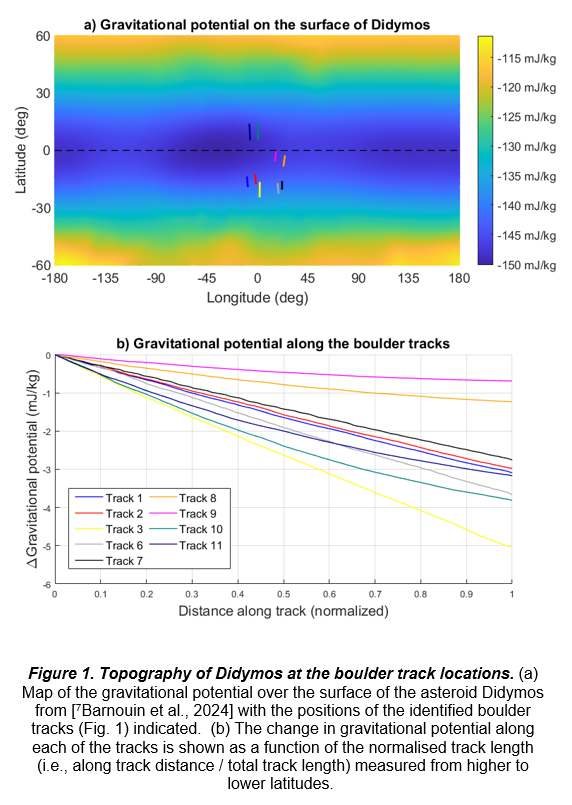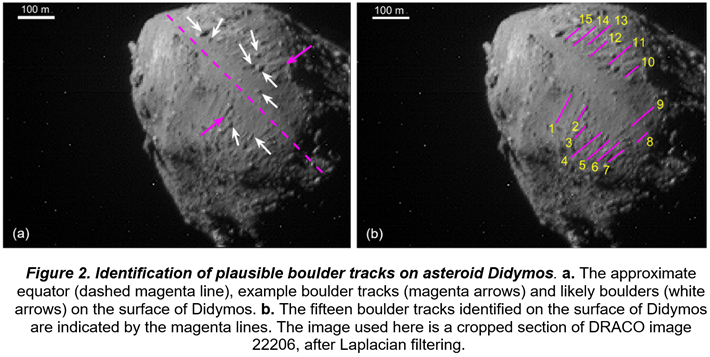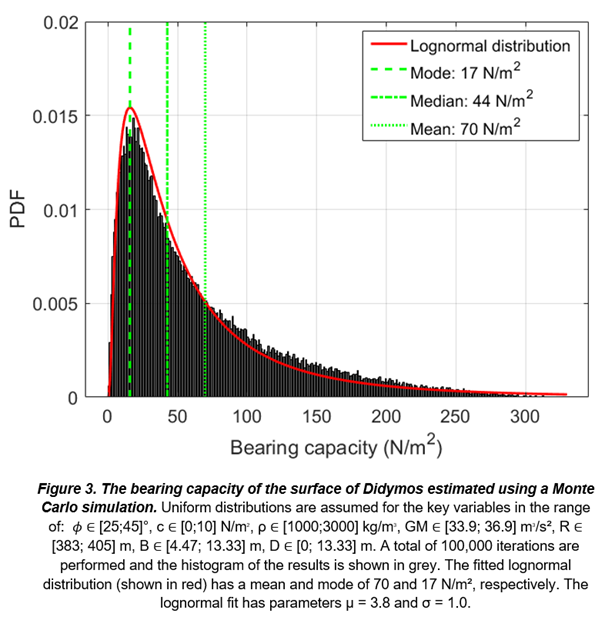- 1Université de Toulouse, ISAE-SUPAERO, DEOS, France (jeanne.bigot@student.isae-supaero.fr)
- 2University Colorado, Boulder, USA
- 3Climate & Space Sciences and Engineering, University of Michigan, Ann Arbor, MI, USA
- 4University of Maryland, USA
- 5DLR, Germany
- 6Johns Hopkins Applied Physics Laboratory, USA
- 7Université Côte d’Azur, Observatoire de la Côte d’Azur, CNRS, Laboratoire Lagrange, France
- 8University of Alicante, Spain
- 9INAF - OAPD Astronomical Observatory of Padova, Italy
Introduction: In 2022, the NASA DART spacecraft performed a kinetic impact on the asteroid Dimorphos. This first attempt of asteroid deflection was highly effective and demonstrated the feasibility of modifying an asteroid trajectory. The on-board camera, DRACO, captured images of the binary asteroids Didymos and Dimorphos during the approach. These images showed Didymos to have a relatively smooth equatorial region compared to the polar terrains. Linear groove-like features perpendicular to the equator can be seen.
In this work, we use the DRACO images and boulder tracks visible on the surface to apply a previously validated geotechnical approach [1] and estimate the bearing capacity of the surface of the primary asteroid Didymos. Our findings have been accepted for publication at Nature Communications [2].
Geotechnical properties of asteroids affect their geology and evolution [3] and are important parameters in numerical models of the formation and history of small bodies. Moreover, they are also important for any space mission involving surface operations or interactions [4]. The ultimate bearing capacity is the maximum pressure that a surface can withstand without experiencing shear failure [5].
Methods: Image processing solutions were used to visualize and measure the boulder tracks. We applied a Laplacian filter that increases the visibility of the contours by enhancing the zones with high intensity gradients. To quantify the influence of image resolution on our measurements, we conducted successive degradations of resolution that showed measurement errors up to ~10%. The bearing capacity estimate takes into account a possible error of one pixel (~50% error) on the track width measurements.
The values for Didymos’ size, mass, gravity field and spin rate [6] show a very small effective gravity, that combines both gravitational and centripetal accelerations. The topographic data from [7] provides evidence for a change in gravitational potential on the surface of Didymos. The surface presents a minimum of geopotential at the equator (Fig. 1) due to the fast rotation of Didymos, supporting the hypothesis of the observed lineaments being tracks formed by boulders moving on the granular soil. The coordinates in latitude and longitude of these tracks were measured using the Small Body Mapping Tool [8] to locate them on the gravitational potential map (Fig. 1). The change in gravitational potential along each track is reported in Fig. 1, and shows a lower gravitational potential at the end of all the tracks, indicating that the boulders would have moved towards the equator to minimise their geopotential.

Results: From the DRACO images, 15 possible boulder tracks are identified on the surface of Didymos, shown in Fig. 2b, among which 9 are chosen to be studied further. We measure manually the width and length of each track in the processed images. The track widths have a mean and standard deviation of 8.9 +/- 1.5 m.

Using the track width measurements, we applied the Terzaghi equation, previously applied to the lunar soil [1, 9], that relates the shear strength of the soil to the material properties and the track measurements. We performed Monte Carlo simulations to account for the uncertainty in the key parameters (friction angle, cohesion and density) which we vary within their expected ranges found in recent studies [6, 7, 10, 11]. We find an average bearing capacity of 70 N/m² (Fig. 3).

Conclusion: The linear features observed on Didymos seem to be tracks formed by boulders moving down the gravitational slope towards the equator. From the 9 tracks identified, we find an average boulder track width of 8.9 +/- 1.5 m. Using a geotechnical approach, we estimated the mean bearing capacity of Didymos to be 70 N/m². This means that every 1 m² of Didymos’ surface can support only ~70 N of force before experiencing shear failure. This is at least 1000 times smaller than the bearing capacity of dry sand on Earth (~105 N/m²). The upcoming ESA Hera mission will return on site in 2026 and provide high resolution images of Didymos. This will provide confirmation that the observed features are indeed tracks formed by boulders.
Our work will also be put into practice through an experimental project that was selected for the ESA Academy Experiment Programme, led by a student team from ISAE-SUPAERO in France. Sinkage experiments in low gravity conditions will be conducted using the ZARM drop tower, in order to measure the bearing capacity of surface materials and test the influence of cohesion.
Acknowledgements: We acknowledge funding support from the French Space Agency (Centre National d’Etudes Spatiales; CNES), support from the French ANR Tremplin-ERC ‘GRAVITE’, and funding from the European Union (ERC, GRAVITE, 101087060).
References:
1. Bickel, V. T. et al. Analysis of Lunar Boulder Tracks: Implications for Trafficability of Pyroclastic Deposits. Geophys. Res. Planets 124, 1296–1314 (2019).
2. Bigot, J., Lombardo, P. et al. The bearing capacity of asteroid (65803) Didymos estimated from boulder tracks. Nature Communications, accepted (2024).
3. Sánchez, P. Asteroid Evolution: Role of Geotechnical Properties. Proc. Int. Astron. Union 10, 111–121 (2015).
4. Zacny, K. et al. Chapter 8 - Geotechnical Properties of Asteroids Affecting Surface Operations, Mining, and In Situ Resource Utilization Activities. in Primitive Meteorites and Asteroids (ed. Abreu, N.) 439–476 (Elsevier, 2018).
5. Terzaghi, K. Theoretical Soil Mechanics. (J. Wiley and Sons, Inc.; Chapman and Hall, Limited, New York, London, 1943).
6. Naidu, S. P. & Chesley, S. Dimorphos orbit solution, JPL Memo s542. (2023).
7. Barnouin, O. S. et al. The geology and evolution of the Near-Earth binary asteroid system (65803) Didymos. Nature Communications, accepted (2024)
8. Sargeant, H. M. et al. Using Boulder Tracks as a Tool to Understand the Bearing Capacity of Permanently Shadowed Regions of the Moon. Geophys. Res. Planets 125, (2020).
9. Ernst, C. M. et al. The Small Body Mapping Tool (SBMT) for accessing, visualizing, and analyzing spacecraft data in three dimensions. LPSC 49, abstract #1043 (2018)
10. Pajola, M. et al. Evidence for multi-fragmentation and mass shedding of boulders on rubble-pile binary asteroids. Nature Communications, submitted (2024).
11. Robin C. Q. et al. Mechanical properties of rubble pile asteroids (Dimorphos, Itokawa, Ryugu, and Bennu) through surface boulder morphological analysis. Nature Communications, accepted (2024)
How to cite: Bigot, J., Lombardo, P., Murdoch, N., Scheeres, D. J., Vivet, D., Zhang, Y., Sunshine, J., Vincent, J.-B., Barnouin, O. S., Ernst, C. M., Daly, T., Sunday, C., Michel, P., Campo-Bagatin, A., Lucchetti, A., Pajola, M., Rivkin, A. S., and Chabot, N. L.: Estimating the bearing capacity of asteroid (65803) Didymos using boulder track measurements, Europlanet Science Congress 2024, Berlin, Germany, 8–13 Sep 2024, EPSC2024-395, https://doi.org/10.5194/epsc2024-395, 2024.